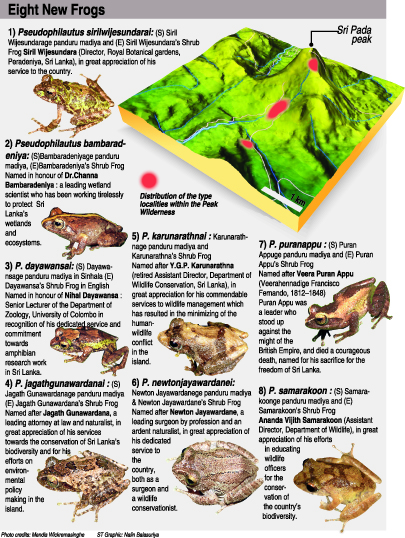News
Eight new shrub frogs discovered from the Peak Wilderness
View(s):By Malaka Rodrigo
Sri Lanka’s fame as a global amphibian hotspot got a further boost last week with the discovery of eight new amphibian species.
This discovery, takes the number of amphibians found in Sri Lanka to 119 with 103 being found only in this country and was published in the prestigious ‘Journal of Threatened Taxa’.
The new species possess unique characteristics that make them distinct from one another and easily identifiable in the field, Mendis Wickremasinghe of the Herpetological Foundation of Sri Lanka who made the discoveries with his research team said. However the conservation status of the species except for one has to be seen as “Critically Endangered”, as they were discovered in single locations where their habitats are under threat, he said.
The discoveries were made by the research team during a study of herpetofaunal diversity (diversity of amphibians and reptiles) in the Sri Pada World Heritage site. The frogs were discovered along the trail leading from Palabaddala to the Sri Pada Peak, and the trail from Erathna/Kuruvita to the Sri Pada Peak during phase I and Phase II of the project conducted from 2009 to 2011.
Acknowledging the hard work carried out by the research team that included himself, Dulan Ranga Vidanapathirana, Gehan Rajeev, Chathuranga Ariyarathne, Amila Chanaka, Nethu Wickramasinghe, Imesh Nuwan Bandara and Dharshana Priyantha, Mr. Wickremesinghe said they braved the chilly nights and harsh conditions of the Peak Wilderness during the survey. Amphibians are mostly nocturnal creatures and the team guided by GPS locators, cameras and other equipment followed the amphibians in leech-infested territories.
The new species belong to the Pseudophilautus group that includes shrub frogs known as Panduru Mediya in Sinhala. This genus Pseudophilautus consists of 65 known species that are endemic to Sri Lanka. This group of frogs is believed to have separated from India long time ago with their evolution to taking place in isolation in Sri Lanka. Most of the shrub frogs are direct developers that are born directly from eggs, bypassing the tadpole stage. Therefore they don’t need to live near a waterway and can survive on moist cloud forests like the Peak Wilderness.
The researchers named these amphibians after eight individuals who play a role in protecting the environment or the conservation of wildlife. Among them are leading ecologists and botanists, Dr.Channa Bambaradeniya, Dr. Siril Wijesundara, Dr.Nihan Dayawansa and environmental activist Jagath Gunawardane. Wildlife officers Y.G.P. Karunarathna, Vijith Samarakoon have also been honoured while a leading surgeon and ardent naturalist Dr. Newton Jayawardane too has been recognized.
One of the frogs has been named after Veera Puran Appu (1812–1848) a freedom fighter who stood up to the might of the British rulers.
The researchers rate the Peak Wilderness as one of the most threatened habitats of Sri Lanka as its unique cloud forest is surround by tea plantations that are rapidly encroaching the forest. In addition pilgrims to Sri Pada due to ignorance contribute to the pollution of this virgin forest. Attempts to build a helipad at the summit, and moves to introduce a cable car system have been condemned by environmentalists and researchers. The latter group fears that the unique biodiversity of the Peak Wilderness will be lost, even before it is discovered.
Mr. Wickrememsinghe said their ongoing survey at Peak Wilderness would lead to more discoveries in the future, adding that he was grateful to the Biodiversity Secretariat of the Ministry of Environment, Nagao Natural Environment Foundation, and Dilmah Conservation for funding the survey.
| Extinct frog leaps out after 157 years
A frog believed to be extinct was re-discovered after 157 years in the Peak Wilderness. The discovery made by Mendis Wickremasinghe and his team of researchers was published in the international Journal ‘Zootaxa’. |
Follow @timesonlinelk
comments powered by Disqus



















